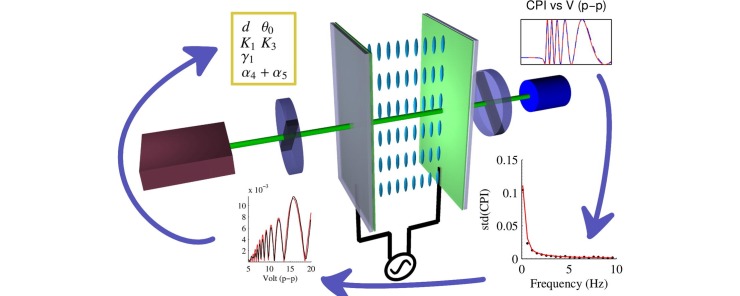Optical characterisation of liquid crystal materials
We have developed a new technique, that uses a periodic modulation of the voltage applied to the cell, to measure two sets of liquid crystal viscosity parameters [1]
Graphical abstract of Bennett et al (2017), J. Colloid Interface Sci. – We measure the cross-polarised intensity through a nematic liquid crystal cell at different frequencies of the applied voltage (high, top right; low, bottom right; intermediate, bottom left). Statistical analysis of these curves give the parameters listed on the top left.
Also a methodology to extract wide area information about nematic liquid crystal cells, e.g. a map of the cell thickness or of the pretilt angle has been developed. These measurements coupled with a bootstrapping statistical analysis allows us to obtain accurate measurements of the liquid crystal properties, e.g. its elastic constants [2].
PI planar cell filled with E7: spatial map of the liquid crystal (a) thickness and (c) pretilt angle; (b) and (d) are the corresponding errors. Circles are the fitted values, and the background color map is a piece-wise cubic interpolation between them.
The end result of this research project is a new instrument, the Optical Multi-Parameter Analysis (OMPA) [see Product Development and Applied Research Section]
We have developed a new technique, called voltage transfer function, a rapid and visually effective method to determine the electrical response of liquid crystal systems using optics. This method relies on cross polarized intensity measurements as a function of the frequency and amplitude of the voltage applied to the device. Coupled with a mathematical model of the device it can be used to determine the device’s time constants and electrical properties. There is considerable interest in the development of new aligning materials for liquid crystal devices to make them easier to fabricate and introduce less impurities in the process. Thin layers of different types of polymers or surfactants deposited on the device substrates typically are used for that purpose and, in most cases, play a passive role when considering the optical or electrical response. However, frequently their interface with liquid crystals can influence the electric field profile extending into the devices and ionic effects can be present, especially if impurities are present or as a result of long term exposure to light and electric field. Our method has been successfully demonstrated in standard, LC cells, as well as in those with photo-active surface layers, including accumulated space charge layers [3].
Comparison of measured (left column) crosspolarized intensity as a function of voltage and frequency for the E7 cell with that (right column) given by a nonlinear filter model.
1. T.P. Bennett, M.B. Proctor, M. Kaczmarek and G. D’Alessandro, Lifting degeneracy in nematic liquid crystal viscosities with a single optical measurement, J. Colloid Interface Sci. 497, 201-206 (2017)
https://doi.org/10.1016/j.jcis.2017.03.020
2. T.P. Bennett, M.B. Proctor, J.J. Forster, E. Perivolari, N. Podoliak, M. Sugden, R. Kirke, T. Regrettier, T. Heiser, M. Kaczmarek and G. D’Alessandro, Wide area mapping of liquid crystal devices with passive and active command layer, Appl. Optics 56, 9050-9056 (2017)
https://doi.org/10.1364/AO.56.00905010.1016
3. J. Bateman, M. Proctor, O. Buchnev, N. Podoliak, G. D’Alessandro and M. Kaczmarek, Voltage transfer function as an optical method to characterize electrical properties of liquid crystal devices, Opt. Lett. 39(14), 3756-3759 (2014)


